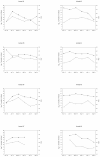Development and evaluation of a real-time PCR assay for the quantitative detection of Theileria annulata in cattle
- PMID: 22889141
- PMCID: PMC3432606
- DOI: 10.1186/1756-3305-5-171
Development and evaluation of a real-time PCR assay for the quantitative detection of Theileria annulata in cattle
Abstract
Background: The tick-borne apicomplexan bovine parasite Theileria annulata is endemic in many tropical and temperate areas, including Minorca (Balearic Islands, Spain). Real-time PCR is widely used for the detection of piroplasms but quantification is not commonly considered.
Results: We developed a real-time quantitative PCR (qPCR) assay for the detection and quantification of T. annulata that included an internal amplification control (IAC) to monitor for the presence of potential inhibitors. Specificity, sensitivity, precision, linear range and PCR efficiency were calculated and different methods for transformation of quantification cycle (Cq) values into quantities (Q) were evaluated. The assay was able to detect (100% probability) and quantify (linear response) 100 gene copies, and clinical sensitivity was set at 10 T. annulata per μl of blood. The assay was then validated on 141 bovine blood samples analyzed in parallel by a Luminex® suspension array, showing the utility of the qPCR assay developed here for the detection and quantification of the parasite in field conditions. Once validated it was used to monitor T. annulata parasitaemia throughout a year in 8 carrier animals from a farm in Minorca.
Conclusions: The developed qPCR assay offers a reliable and simple way to quantify T. annulata infection loads, which could prove crucial in studying the role of carrier animals as a source of the infection, or assessing the efficacy of treatment and control measures.
Figures



Similar articles
-
Qualitative and quantitative assessment of Theileria annulata in cattle and buffaloes Polymerase Chain Reaction.Trop Biomed. 2014 Dec;31(4):728-35. Trop Biomed. 2014. PMID: 25776598
-
Simultaneous detection of Theileria annulata and Theileria orientalis infections using recombinase polymerase amplification.Ticks Tick Borne Dis. 2018 May;9(4):1002-1005. doi: 10.1016/j.ttbdis.2018.03.028. Epub 2018 Mar 28. Ticks Tick Borne Dis. 2018. PMID: 29625920
-
Establishment and application of TaqMan real-time PCR method for detection of Theileria annulata resistant to buparvaquone.Vet Parasitol. 2024 Jun;328:110183. doi: 10.1016/j.vetpar.2024.110183. Epub 2024 Apr 9. Vet Parasitol. 2024. PMID: 38608378
-
Bovine piroplasms in Minorca (Balearic Islands, Spain): a comparison of PCR-based and light microscopy detection.Vet Parasitol. 2001 Aug 20;99(3):249-59. doi: 10.1016/s0304-4017(01)00464-2. Vet Parasitol. 2001. PMID: 11502372
-
Reverse line blot hybridization used to identify hemoprotozoa in Minorcan cattle.Ann N Y Acad Sci. 2002 Oct;969:78-82. doi: 10.1111/j.1749-6632.2002.tb04354.x. Ann N Y Acad Sci. 2002. PMID: 12381567
Cited by
-
A PCR-RFLP Assay targeting RPS8 gene for the discrimination between bovine Babesia and Theileria species in China.Parasit Vectors. 2015 Sep 17;8:475. doi: 10.1186/s13071-015-1085-x. Parasit Vectors. 2015. PMID: 26382041 Free PMC article.
-
Environmental sampling coupled with real-time PCR and genotyping to investigate the source of a Q fever outbreak in a work setting.Epidemiol Infect. 2017 Jul;145(9):1834-1842. doi: 10.1017/S0950268817000796. Epub 2017 Apr 24. Epidemiol Infect. 2017. PMID: 28434420 Free PMC article.
-
Evaluating an indirect rMPSP enzyme-linked immunosorbent assay for the detection of bovine Theileria infection in China.Parasitol Res. 2017 Feb;116(2):667-676. doi: 10.1007/s00436-016-5332-7. Epub 2016 Dec 10. Parasitol Res. 2017. PMID: 27942962
-
Important hemoprotozoan diseases of livestock: Challenges in current diagnostics and therapeutics: An update.Vet World. 2016 May;9(5):487-95. doi: 10.14202/vetworld.2016.487-495. Epub 2016 May 20. Vet World. 2016. PMID: 27284225 Free PMC article. Review.
-
Rapid and visual detection of porcine deltacoronavirus by recombinase polymerase amplification combined with a lateral flow dipstick.BMC Vet Res. 2020 May 7;16(1):130. doi: 10.1186/s12917-020-02341-3. BMC Vet Res. 2020. PMID: 32381014 Free PMC article.
References
-
- Preston PM. In: Encyclopedia of arthropod-transmitted infections of man and domesticated animals. Service MW, editor. Wallingford, UK: CABI Publishing; 2001. Theilerioses; pp. 487–502.
-
- Uilenberg G. In: Encyclopedia of arthropod-transmitted infections of man and domesticated animals. Service MW, editor. Wallingford, UK: CABI Publishing; 2001. Babesiosis; pp. 53–60.
-
- Estrada-Peña A, Bouattour A, Camicas J-L, Walker AR. Ticks of domestic animals in the Mediterranean region. A guide to identification of species. Zaragoza, Spain: University of Zaragoza; 2004.
-
- Habela M, Rol JA, Antón JM, Pena J, Corchero E, Van HI, Jongejan E. Epidemiology of Mediterranean theileriosis in Extremadura region, Spain. Parassitologia. 1999;41(Suppl 1):47–51. - PubMed
Publication types
MeSH terms
Substances
LinkOut - more resources
Full Text Sources
Molecular Biology Databases

